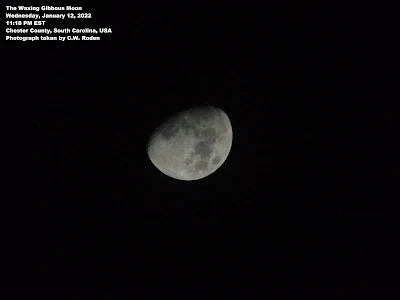Good evening, y'all!
Well, my first night sky photographic offering of 2022 are ones I think y'all will thoroughly enjoy. They involve two beautiful star clusters: the Pleiades and the Hyades.
This evening several hours after sunset the Waxing Gibbous Moon could be seen with the faint Pleiades Star Cluster in the night sky.
The Pleiades (Seven Sisters) could be seen just outside of Luna's glare. I took one photo using the trunk of a tree to block out the Moon's glare and get what turned out to be a really beautiful shot of all of the major stars in the star cluster. The Pleiades are about 444 light-years away from our Sun.
My second photo is a wide shot with the tree in the foreground of the moon and Pleiades with three of the major stars of the Winter Hexagon asterism: Aldebaran, Rigel, and bright Sirius just visible in the corner of the photograph. Rigel, along with the stars Betelgeuse and Bellatrix are the three brightest in that order that make up the Constellation Orion The Hunter outlined in the photo.
The second star cluster visible with Luna in the night sky tonight is the V-shaped Hyades cluster, which makes up the "head" of the Constellation Taurus The Bull. The brightest star is Aldebaran: the Eye of the Bull. This cluster is easy to locate using the Orion's Belt asterism as a line to Aldebaran.
Although not a true member of the Hyades star cluster, the bright reddish star is a great guide to this cluster. Aldebaran is only about 65 light-years distant. The Hyades themselves are about 153 light-years distant, with Aldebaran in the light of sight between the cluster and our Sun.
In the Northern Hemisphere, both the Pleiades and the Hyades star clusters are best seen in the evening sky from around January to April. Both star clusters are made up of many more fainter stars that are not visible to the naked eye (especially closer to city lights) but can be seen with the aid of a telescope, binoculars, or a really good camera lens.
And finally, my last offering to start out 2022 is a pretty beautiful shot of our dear Luna in her Waxing Gibbous Phase.
Well folks, I hope y'all enjoyed my offerings for the evening. Tomorrow evening, in the Northern Hemisphere, the moon's path with take it close to Aldebaran. Be sure to check it out -- clear skies permitting, of course.
Until next time have a wonderful evening and be sure to keep your eyes to the night skies, y'all hear!




No comments:
Post a Comment